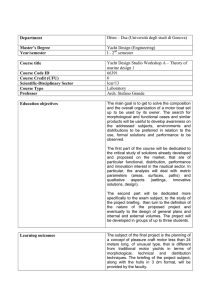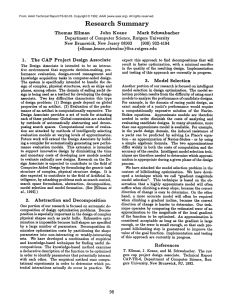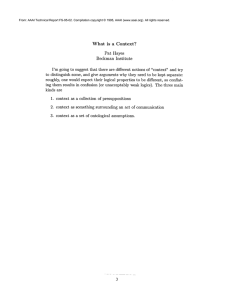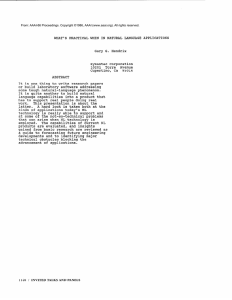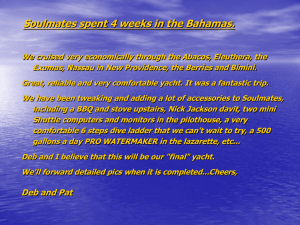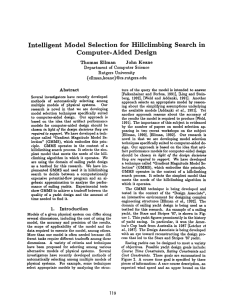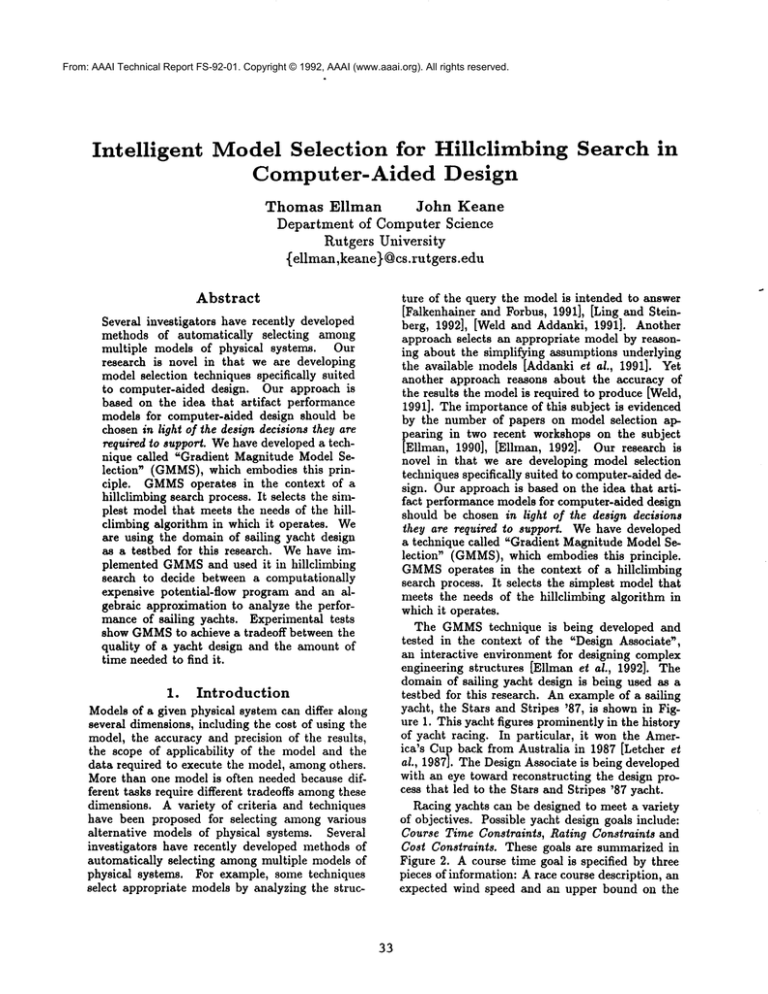
From: AAAI Technical Report FS-92-01. Copyright © 1992, AAAI (www.aaai.org). All rights reserved.
Intelligent
Model Selection
for Hillclimbing
Computer-Aided
Design
Search in
Thomas Ellman
John
Keane
Department
of Computer Science
Rutgers University
{ ell man,ke ane } @cs. rut gers. edu
Abstract
ture of the query the model is intended to answer
[Falkenhainer and Forbus, 1991], [Ling and Steinberg, 1992], [Weld and Addanki, 1991]. Another
approach selects an appropriate model by reasoning about the simplifying assumptions underlying
tile available models [Addanki et al., 1991]. Yet
another approach reasons about the accuracy of
the results the model is required to produce [Weld,
1991]. The importance of this subject is evidenced
by the number of papers on model selection appearing in two recent workshops on the subject
[Ellman, 1990], [Ellman, 1992]. Our research is
novel in that we are developing model selection
techniques specifically suited to computer-aided design. Our approach is based on the idea that artifact performance models for computer-aided design
should be chosen in light of the design decisions
they are required to support. Wehave developed
a technique called "Gradient Magnitude Model Selection" (GMMS),which embodies this principle.
GMMS
operates in the context of a hillclimbing
search process. It selects the simplest model that
meets the needs of the hillclimbing algorithm in
which it operates.
The GMMStechnique is being developed and
tested in the context of the "Design Associate",
an interactive environment for designing complex
engineering structures [Ellman et al., 1992]. The
domain of sailing yacht design is being used as a
testbed for this research. An example of a sailing
yacht, the Stars and Stripes ’87, is shownin Figure 1. This yacht figures prominently in the history
of yacht racing. In particular, it won the America’s Cup back from Australia in 1987 [Letcher et
al., 1987]. The Design Associate is being developed
with an eye toward reconstructing the design process that led to the Stars and Stripes ’87 yacht.
Racing yachts can be designed to meet a variety
of objectives. Possible yacht design goals include:
Course Time Constraints, Rating Constraints and
Cost Constraints. These goals are summarized in
Figure 2. A course time goal is specified by three
pieces of information: A race course description, an
expected wind speed and an upper bound on the
Several investigators have recently developed
methods of automatically
selecting among
multiple models of physical systems. Our
research is novel in that we are developing
model selection techniques specifically suited
to computer-aided design. Our approach is
based on the idea that artifact performance
models for computer-aided design should be
chosen in light of the design decisions they are
required to support. Wehave developed a technique called "Gradient Magnitude Model Selection" (GMMS),which embodies this principle. GMMSoperates in the context of a
hillclimbing search process. It selects the simplest model that meets the needs of the hillclimbing algorithm in which it operates. We
are using the domain of sailing yacht design
as a testbed for this research. Wehave implemented GMMS
and used it in hillelimbing
search to decide between a computationally
expensive potential-flow program and an algebraic approximation to analyze the performance of sailing yachts. Experimental tests
show GMMS
to achieve a tradeoff between the
quality of a yacht design and the amount of
time needed to find it.
1. Introduction
Models of a given physical system can differ along
several dimensions, including the cost of using the
model, the accuracy and precision of the results,
the scope of applicability
of the model and the
data required to execute the model, amongothers.
More than one model is often needed because different tasks require different tradeoffs amongthese
dimensions. A variety of criteria and techniques
have been proposed for selecting among various
alternative models of physical systems. Several
investigators have recently developed methods of
automatically selecting amongmultiple models of
physical systems. For example, some techniques
select appropriate models by analyzing the struc-
33
From: AAAI Technical Report FS-92-01. Copyright © 1992, AAAI (www.aaai.org). All rights reserved.
Cour~
Wind-Speed L_J
Time
~V~lo~tyfWind-Sp~d.H~g)
//
/
/
(HuH
Processing
Models)
Yacht Geometry
/1\
Figure 1: The Stars and Stripes ’87
OPl
CourseTime(Yacht,
Rating(Yacht) <_
Cost(Yacht)
OP2
-..
OPN
Shape Modification
Operators
Course, WindSpeed) <_
Figure 3: Velocity Prediction Program
<
Figure 2: Racing Yacht Design Goals
time for the yacht to traverse the given course under the given wind conditions. In the Design Associate, the course time is estimated using a velocity
prediction program, called "VPP" [Letcher, 1991].
The rating goal is imposed by the authorities who
manage the America’s Cup races. It requires that
the "rating" of each yacht be at most "12 meters".
Ratings of yachts are determined by a complex set
of rules known as the "International Measurement
System" devised by the Offshore Racing Council
[Council, 1991]. The Design Associate estimates
the rating of a yacht using a simplified formula depending on a few major geometric measurements
of the yacht hull. Finally, a cost goal is specified
by providing an upper bound on the cost of building the yacht. The Design Associate estimates cost
using another simple formula depending on a few
major geometric measurements of the yacht hull.
Of all the quantities appearing in the design
goals, course time is the most difficult to evaluate. The VPP program that performs this task
is described in Figure 3. VPP takes as input a
set of B-Spline surfaces representing tile geometry
of the yacht hull [Rogers and Adams, 1990]. Each
surface is itself represented as a matrix of "control
points" that define its shape. VPPbegins by using
the "hull processing models" to determine physically meaningful quantities impacting on the performance of the yacht, e.g., wave resistance (R~),
friction resistance (Ry), effective draft (Te/y),
tical center of gravity (Vcg) and vertical center
34
pressure (Zcp), amongothers. These quantities are
then used in the "velocity prediction model" to
set up non-linear equations describing the balance
of forces and torques on the yacht. The velocity
prediction model uses an iterative method to solve
these equations and thereby determine the "velocity polar", i.e., a table giving the velocity of the
yacht under various wind speeds and directions of
heading. Finally, the "race model" uses the velocity polar to determine the total time to traverse the
given course, assuming the given wind speed.
2.
Modeling
Choices
in Yacht
Design
A number of modeling choices arise in the context
of sailing yacht design. These choices are outlined
in Figure 4. Probably the most important is the
choice of models for estimating the effective draft
(Tey#) of a yacht. Effective draft is a measure
the amount of drag produced by the keel as a result of the lift it generates. An accurate estimate of
this quantity is quite important for analyzing the
performance of a sailing yacht. Unfortunately, the
most accurate way to estimate effective draft is to
run a highly expensive potential flow code called
PMARC. (This code takes approximately
one
hour when running on a Sun Microsystems Sparc 2
Workstation.) Effective draft can also be estimated
using an algebraic approximation with the general
form outlined below:
Te## = Kx/D~" - 2A,,,/~
D = Maximum Keel Draft
Am, = Midship Hull Cross Section
Area
From: AAAI Technical Report FS-92-01. Copyright © 1992, AAAI (www.aaai.org). All rights reserved.
¯
CANOB-BODIB8
¯ AlgebraicApproximations
v. Computational
Fluid-Dynamics:
The effective
draftTel!of a
yachtcan be estimated
usingan algebraic
approximation
or by usinga potential
flowcode
called
"PMARC’.
¯ Reuse of Prior Results v. Recomputation of Results: Somephysical quantities may not change
significantly
when a design is modified. For a
given physical quantity, its value may be retrieved from a prior candidate design, or its value
may be recomputed from scratch.
¯ Linear Approximations v. Non-Linear Models:
Velocity polars can be computed as linear functions of resistances and geometric quantities or
by directly solving non-linear force and torque
balancing equations.
Te~’-0
Rw-0
Rw-|
Rw-2
Rw-3
Rw.-4 Rw-5
Teff-1
Te~’-2
KEELS
Tdf-3
Teff-3
Rw-3
Teff-4
TeH-$
Figure5: Reuseof PriorResults
3. Gradient Magnitude Model
Selection
Figure4: Modeling
Choicesin YachtDesign
Thisalgebraic
modelis basedon an approximation
thattreats
a sailing
yacht
hullasaninfinitely
long
cylinder
andtreatsthekeelof theyachtas an infinitely
thinfinprotruding
fromthecylinder.
The
constant
K is chosento fitthealgebraic
modelto
dataobtained
fromwavetanktests,or fromsample runsusingthe PMARCpotentialflowcode.
Although
the algebraic
approximation
is comparatively
easyto use,itsresults
arenotas accurate
as thoseproducedby the PMARCpotentialflow
code.
Anotherimportant
modeling
choiceinvolves
the
decision
of whentoreusetheresults
of a priorcomputation.
Theimportance
of thistypeofdecision
is
illustrated
by Figure
5. Suppose
a designer
is systematically
exploring
combinations
of canoe-bodies
andkeelsof a sailingyacht.In orderto evaluatetheperformance
of a yacht,he mustevaluate
theyacht’s
waveresistance
P~ as wellas itseffectivedraftTell.Waveresistance
depends
mainlyon
thecanoe-body
of theyachtandis notsignificantly
influenced
by the keel.Thuswhenonlythe keel
is modified,
waveresistance
willnotsignificantly
change.Thus,instead
of recomputing
waveresistanceforthenewyacht,thesystemcanreusethe
priorvalue.
On theotherhand,effective
draftdependsmainly
on thekeelof theyachtandis notsignificantly
influenced
by thecanoe-body.
Thuswhen
onlythecanoe-body
ismodified,
effective
draftwill
notsignificantly
change.
Thus,instead
of recomputing
effective
draftforthenewyacht,
thesystem
canreusethepriorvalue.
Infact,theentire
matrix
of yachts
canbe evaluated
by computing
waveresistancefora single
row,andcomputing
effective
draft
fora singlecolumn.
Thusby intelligently
deciding
whento reusepriorevaluation
results,
thesystem
can achieveconsiderable
savingsin the computational
costs
of design.
35
GradientMagnitudeModel Selection(GMMS)
a technique
usedin theDesignAssociate
forselecting
evaluation
models
in thecontext
of a hillclimbingsearchprocedure.
The key ideabehind
thistechnique
is illustrated
by Figure6. Suppose
thesystemis running
a hillclimbing
algorithm
to
minimizeCesrseTimeas estimatedby some approximatemodel.The valuesof Co~rseTime
returnedby thisapproximate
modelareindicated
by
thecurved
line.Suppose
further
thatthesystem
is
considering
thehillclimbing
stepillustrated
in the
figure.
If theerrorbarsshownwithsolidlinesreflecttheuncertainty
of theapproximate
model,the
systemcanbe surethattheproposed
stepwilldiminishthe valueof CourseTirr~.
On the other
hand,usingtheerrorbarsshownwithdotted
lines,
the systemwouldbe uncertain
as to whetherthe
truevalueof CourseTirae wouldimprove
aftertakingtheproposed
hillclimbing
step.Inthefirst
case,
thesystemcouldsafelyuse theapproximate
model
to decidewhether
to taketheproposed
hillcliml>ingstep,whilein thesecond
case,theapproximate
modelwouldnotbe safeto use forthatdecision.
ThusGMMSevaluates
thesuitability
of an approximatemodelby comparing
errorestimates
to the
magnitude
of the changein theoptimization
criterionas measuredby the approximate
model.In
orderto operate,GMMSrequiresan approximate
model,a "true"model,andsomemeansof estimatingtheerrorof theapproximate
modelin comparisonto the "true"model.GMMScanin principle
be applied
to anyof themodeling
choices
outlined
inFigure
4.
In our research,we have experimented
with
GMMSusingthe choiceof modelsfor effective
draft,Tell,as a testcase.Thus GMMSchooses
between the algebraic approximate model and the
PMARCpotential
flow model described above.
Our system obtains an error estimate for the al-
From: AAAI Technical Report FS-92-01. Copyright © 1992, AAAI (www.aaai.org). All rights reserved.
1. Let A be a sparse point set in the design space
(Ul,...,u,).
(a) l~un PMARC
to find Tell (u) for each point
in the set A.
(b) Fit coefficients in Alg(A) to minimize average
error over the set A.
2. Let B be a sparse point set in the design space
"r
Approximate
Course
Time
(ul,...,u,).
i
~1
he.ion
Figure 6: Gradient Magnitude Model Selection
gebraic model using the procedure outlined in Figure 7. The procedure takes as input two sets, A and
B, of sample points in the space of candidate yacht
designs. The set A is a small, sparsely distributed
point set, while set B is a larger, more densely
distributed point set. The system constructs two
versions of the algebraic model, by choosing values for the fitting coefficient K, described above.
Alg(A) is fitted against the "true" values from the
sparse point set A. Alg(B) is fitted against the
"true" values from the dense point set B. In each
case the "true" values are determined using the
PMARCas the "gold standard".
Since Alg(B)
is fitted against the denser point set, this modelis
actually used during hillclimbing search; however,
its error is actually estimated using Alg(A), which
was fitted against the sparser point set. In particular, the error in Alg(B) is estimated by comparing
Alg(A) to PMARC
for all points in the set B - A.
Twodifferent error estimates, result from this procedure: Absolute-Error is based on the assumption
that errors in the algebraic model at nearby points
in the design space are independent of each other.
Difference-Error takes into account the possibility that errors for nearby points maybe correlated.
Gradient-magnitude
model selection
(GMMS)
operates in a slightly different manner depending
on which type of error estimate is available. Consider first how Absolute-Error estimates are used.
Given two candidate yacht designs Di and Di+l,
the system first evaluates the effective draft Tell
of each candidate using the algebraic approximation. The estimate of Absolute-Error is then used
to find upper and lower bounds on the effective
draft Tell of eac~ candidate. Each pair of bounds
is then propagated through the rest of the velocity
prediction program (Figure 3) to obtain an upper
and lower bound on the CourseTime of each candidate. If the CourseTime intervals do not overlap,
then the system knows whether to take a step from
candidate D~ to D~+I based on the results of the algebraic approximate model. On the other hand, if
36
(a) Run PMARCto find Tell (u) for each point u
in the set B.
(b) Fit coefficients of Alg(B) to minimize average
error over the set B.
3. Estimate the error of Alg(A) using the PMARC
as the "gold standard":
¯ Absolute-Error(Alg(A))
= Average error in
Tell over all points in B - A.
¯ Dif/erence-Error(Alg(A))
= Average error in ITe/y(u)- Te//(ur)l
as function of
Aul,..., Zku,, over all pairs (u,u’) of points
in B-A.
Figure 7: Error Estimation Technique
the intervals do overlap, then the system must use
PMARCto obtain a better estimate of effective
draft Tel! for each candidate. WhenDifferenceError estimates are available, GMMS
operates differently. After computingthe effective draft of each
candidate, the system considers two scenarios: (1)
All of the Difference-Error occurs in the Tell of
Di, and none occurs in the Tel! of D~+I; (2) All
the Difference-Error occurs in the Tell of D~+I,
and none occurs in the Tell of Di. In each case the
system propagates the Difference-Error through
the rest of the velocity prediction program, to obtain bounds on the CourseTime of each candidate.
The algebraic approximate model is considered acceptable only if the CourseTimeintervals are disjoint under both scenarios. Similar methods can be
used to apply Gradient Magnitude Model Selection
to the other modeling choices shown in Figure 4.
4. Experimental
Tests
Results from a preliminary test of gradient magnitude model selection are show in Figure 9. The
data in this graph was collected by using a hillclimbing algorithm to modify the Stars and Stripes
’87yachtto sailin a newenvironment
withan averagewind speedof 16 knots.The graphshows
how the valueof CourseTime
changedduringthe
hillclimbing
process.
Pointsmarkedwitha diamond indicateCourseTimevaluescomputedusing the algebraic
approximation.
Pointsmarked
witha plussignindicate
CourseTime
valuescomputedusingthe PMARCpotential
flowcode.(The
From: AAAI Technical Report FS-92-01. Copyright © 1992, AAAI (www.aaai.org). All rights reserved.
PMARC Only
GMMS
AlgebraicOnly
Course Time PMARCs
281
11730.8
11747.0
104
11757.9
0
Figure 8: Performance of Gradient
Model Selection
Rutgers CAPproject, including Saul Amarel, Andrew Gelsey, HaymHirsh, Chun Liew, Ringo Ling,
Gerry Richter, Louis Steinberg, Mark Schwabacher,
Chris Tong and Ke-Thia Yao. This research
was supported by the Defense Advanced Research
Projects Agency (DARPA)and the National Aeronautics and Space Administration (NASA), under
DARPA-funded NASAgrant No. NAG 2-645.
Magnitude
graph shows only a fraction of the number of evaluations carried out during the entire design process. In particular, evaluations used to compute
gradients are not shown.) Notice that the algebraic modelwas sufficient to verify progress toward
a better design during iterations zero through five.
During this portion of the search, the changes in
CourseTirne at each iteration were quite large. Improvements could therefore be verified using the algebraic model. During subsequent iterations,
the
CourseTime curve leveled off. The system was
then forced to switch to the PMARCmodel in
order to verify improvementsfrom one iteration to
the next.
Additional experiments have been run in order to
demonstrate the practical value of gradient magnitude model selection (GMMS).Results from a comparison of three hillclimbing search runs are shown
in Figure 8. These three runs include: (1) run
using PMARCto compute effective draft; (2)
run using GMMSto choose between PMARCand
the algebraic approximation; and (3) A run using
only the algebraic approximation. Each run attempted to redesign the Stars and Stripes ’87 yacht
to sail in a new environment with an average wind
speed of 16 knots. The three runs are compared according to the quality of the solution, measured in
terms of the CourseTimeof the yacht, and the design time needed to obtain the solution, measured
in terms of the number of PMARCevaluations
needed to obtain the solution. (PMARC
is, by far,
the most expensive of the velocity prediction program shown in Figure 3.) Notice that the GMMS
run found a yacht that was better in quality (lower
in CourseTirne) than the one found using the algebraic approximation, yet GMMS
required less design time (fewer PMARCevaluations) than would
have been necessary had PMARC
been used all the
time. Thus GMMS
implements a tradeoff between
the quality of design and the design time needed to
find it. In the future we plan additional tests of the
practical value of GMMS.
In particular, we plan to
test the value of GMMS
when used to make make
additional modelingchoices, such as those listed in
Figure 4, that arise in the context of racing yacht
design.
5.
Acknowledgments
The research reported in this paper has benefited
from numerous discussions with all membersof the
37
References
S. Addanki, R. Cremonini, and J. Scot. Graphs of
models. Artificial Intelligence, 50, 1991.
Offshore Racing Council. International Measurement System: A Handicapping System for Cruising/Racing Yachts. Offshore Racing Council,
Newport, Rhode Island, 1991.
T. Ellman, J. Keane, and M. Schwabacher. The
rutgers cap project design associate. Technical
Report CAP-TtL-6, Department of Computer Science, Rutgers University, New Brunswick, NJ,
1992.
T. P. Ellman, editor.
Working Notes of the
AAAI Workshop on Automatic Generation of
Approzimations and Abstractions.
Department
of Computer Science, Rutgers University, New
Brunswick, NewJersey, 1990.
T. P. Ellman, editor.
Working Notes of the
AAAI Workshop on Approzimation and Abstraction of Computational Theories. Department
of Computer Science, Rutgers University, New
Brunswick, NewJersey, 1992.
B. Falkenhalner and K. Forbus. Compositional
modeling: Finding the right model for the job.
Artificial Intelligence, 50, 1991.
J. S. Letcher, J. K. Marshall, J. C. Oliver, and
N. Salvesen. Stars and stripes. Scientific American, 257(2), August 1987.
J. S. Letcher. The Aero/Hydro VPP Manual.
Aerh/Hydro, Incorporated,
Southwest Harbor,
Maine, 1991.
R. Ling and L. Steinberg. Model generation from
first principles. March1992.
David F. Rogers and J. Alan Adams. Mathematical elements for computer graphics. McGraw-Hill,
2nd edition, 1990.
D. Weld and S. Addanki. Query-directed approximation. Technical Report 90-12-02, Department
of Computer Science and Engineering, University
of Washington, Seattle, WA,1991.
D. Weld. Reasoning about model accuracy. Technical Report 91-05-02, Department of Computer
Science and Engineering, University of Washington, Seattle, WA,1991.
From: AAAI Technical Report FS-92-01. Copyright © 1992, AAAI (www.aaai.org). All rights reserved.
13400
I
I
I
I
I
I
I
Algebraic Model Evaluations ¯
PMARC Model Evaluations +
13200
13000
12800
o
o
12600
12400
o
o
12200
12000
o
o
11800
11600
I
5
Figure 9: Example of Gradient
Selection
I
i0
Magnitude
I
I
I
25
15
20
Iteration Number
Model
38
I
30
I
35
4O
From: AAAI Technical Report FS-92-01. Copyright © 1992, AAAI (www.aaai.org). All rights reserved.
Research
Summary
Thomas Ellman
John
Keane
Mark Schwabacher
Department of Computer Science,
Rutgers University
New Brunswick,
New Jersey 08903
(908) 932-4184
{eUman,keane,schwabac}@cs.rutgers.edu
1. The CAP Project Design Associate
The DesignAssociate
is intendedto be an interactiveenvironment
thatsupports
decision-making,
performanceevaluation,
design-record
management
and
knowledge
acquisition
tasksin computer-aided
design.
Thesystemis specifically
intended
to handlethedesignof complex,
physical
structures,
suchas shipsand
planes,
amongothers.
Thedomainof sailing
yachtdesignisbeingusedas a testbed
fordeveloping
thedesign
associate.
Twokeydifficulties
characterize
thistype
of designproblem:
(1) Designgoalsdependon global
properties
of an artifact.
(2)Evaluation
of theperformanceof an artifact
is computationally
expensive.
The
DesignAssociate
provides
a setof toolsforattacking
eachof theseproblems:
Global
constraints
areattacked
by methodsof automatically
abstracting
and decomposingsearchspaces.Computational
costsof evaluationareattacked
by methods
of intelligently
selecting
evaluation
modelsat varying
levelsof approximation.
FutureworkwillextendtheDesignAssociate
by buildinga compiler
forautomatically
generating
newperformanceevaluation
models.Thisextension
is intended
to supportinnovative
designby diminishing
the time
and monetarycostsof developing
new modelsneeded
to evaluate
radically
newdesigns.
Research
on theDesignAssociate
is expected
to contribute
tothefieldof
Computer-Aided
Designby formalizing
thegeneric
task
structure
of complex,
physical
structure
design.
It is
alsoexpected
to contribute
tothefieldofArtificial
Intelligence,
byattacking
problems
suchassearch
control,
searchspaceformulation,
abstraction,
decomposition,
modelselection
and modelformation.
(See[Ellmane$
a/., 1992].)
expectthisapproach
to finddecompositions
thatwill
resultin faster
optimization,
witha minimal
sacrifice
in thequality
of theresulting
design.
Implementation
andtesting
of thisapproach
arecurrently
in progress.
3. Model Selection
Another
portion
of ourresearch
isfocused
on intelligent
modelselection
in designoptimization.
Themodelselection
problem
results
fromthedifficulty
ofusingexact
models
to analyze
theperformance
of candidate
designs.
Forexample,
in thedomainof racingyachtdesign,an
exactanalysis
of a yacht’s
performance
wouldrequire
a computationally
expensive
solution
of theNavierStokesequations.
Approximate
modelsare therefore
neededin orderdiminish
the costsof analyzing
and
evaluating
candidate
designs.
In manysituations,
more
thanoneapproximate
modelis available.
Forexample,
in theyachtdesigndomain,theinduced
resistance
of
a yachtcanbe predicted
by solvingLa Place’sequation- an approximation
of Navier-Stokes
-orby using
a simplealgebraic
formula.The two approximations
differwidelyin boththecostsof computation
andthe
accuracy
oftheresults.
Intelligent
modelselection
techniques
aretherefore
neededto determine
whichapproximation
isappropriate
during
a givenphaseof thedesign
process.
We haveattacked
themodelselection
problem
in the
contextof hillclimbing
optimization.
We havedevelopeda technique
whichwe call"gradient
magnitude
modelselection".
Thistechnique
is basedon theobservation
thata highlyapproximate
modelwilloften
suffice
whenclimbing
a steepslope,
because
thecorrect
direction
of changeis easyto determine.
On theother
hand,a moreaccuratemodelwilloftenbe required
2. Abstraction
and Decomposition
whenclimbing
a gradual
incline,
becausethecorrect
direction
of
change
is
harder
to
determine.
OurtechOne portion of our research is focused on automatic deniqueoperates
by comparing
the estimated
errorof an
composition of design optimization problems. Decomapproximation
to themagnitude
of the localgradient
position is especially important in the design of complex
of
the
function
to
be
optimized.
An approximation
is
physical shapes such as yacht hulls. Exhaustive optiacceptable
as longas thegradient
is large
mization is impossible
because
hullshapes
arespecified considered
enough,
or theerroris smallenough,
so thateachproby a largenumberof parameters.
Decomposition
diposed
hillclimbing
step
is
guaranteed
to improvethe
minishes
optimization
costsby partitioning
theshape
Implementation
andtesting
parameters
intonon-interacting
or weakly-interactingvalueof thegoalfunction.
of
this
approach
are
currently
in
progress.
sets.We havedeveloped
a combination
of empirical
andknowledge-based
techniques
forfinding
usefuldeReferences
compositions.
The knowledge-based
methodexamines
a declarative
description
ofthefunction
to beoptimized
T. Ellman,J. Keane,and M. Schwabacher.
The rutinorderto identify
parameters
thatpotentially
interact
gerscap projectdesignassociate.
Technical
Report
with eachother.The empiricalmethodrunscompuCAP-TR-6,Departmentof ComputerScience,RutgersUniversity,
NewBrunswick,
NJ,1992.
tational
experiments
in orderto determine
whichpotential
interactions
actually
do occurin practice.
We
39

